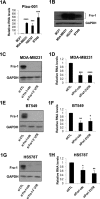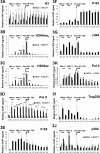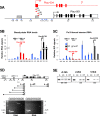Transcriptional complexity and roles of Fra-1/AP-1 at the uPA/Plau locus in aggressive breast cancer
- PMID: 25200076
- PMCID: PMC4176185
- DOI: 10.1093/nar/gku814
Transcriptional complexity and roles of Fra-1/AP-1 at the uPA/Plau locus in aggressive breast cancer
Abstract
Plau codes for the urokinase-type plasminogen activator (uPA), critical in cancer metastasis. While the mechanisms driving its overexpression in tumorigenic processes are unknown, it is regulated by the AP-1 transcriptional complex in diverse situations. The AP-1 component Fra-1 being overexpressed in aggressive breast cancers, we have addressed its role in the overexpression of Plau in the highly metastatic breast cancer model cell line MDA-MB231 using ChIP, pharmacological and RNAi approaches. Plau transcription appears controlled by 2 AP-1 enhancers located -1.9 (ABR-1.9) and -4.1 kb (ABR-4.1) upstream of the transcription start site (TSS) of the uPA-coding mRNA, Plau-001, that bind Fra-1. Surprisingly, RNA Pol II is not recruited only at the Plau-001 TSS but also upstream in the ABR-1.9 and ABR-4.1 region. Most Pol II molecules transcribe short and unstable RNAs while tracking down toward the TSS, where there are converted into Plau-001 mRNA-productive species. Moreover, a minority of Pol II molecules transcribes a low abundance mRNA of unknown function called Plau-004 from the ABR-1.9 domain, whose expression is tempered by Fra-1. Thus, we unveil a heretofore-unsuspected transcriptional complexity at Plau in a reference metastatic breast cancer cell line with pleiotropic effects for Fra-1, providing novel information on AP-1 transcriptional action.
© The Author(s) 2014. Published by Oxford University Press on behalf of Nucleic Acids Research.
Figures






Similar articles
-
Fra-1 regulates its target genes via binding to remote enhancers without exerting major control on chromatin architecture in triple negative breast cancers.Nucleic Acids Res. 2021 Mar 18;49(5):2488-2508. doi: 10.1093/nar/gkab053. Nucleic Acids Res. 2021. PMID: 33533919 Free PMC article.
-
Hyperactivated NF-{kappa}B and AP-1 transcription factors promote highly accessible chromatin and constitutive transcription across the interleukin-6 gene promoter in metastatic breast cancer cells.Mol Cell Biol. 2009 Oct;29(20):5488-504. doi: 10.1128/MCB.01657-08. Epub 2009 Aug 17. Mol Cell Biol. 2009. PMID: 19687301 Free PMC article.
-
FRA-1 expression level regulates proliferation and invasiveness of breast cancer cells.Oncogene. 2005 Feb 17;24(8):1434-44. doi: 10.1038/sj.onc.1208312. Oncogene. 2005. PMID: 15608675
-
The urokinase plasminogen activator system in breast cancer invasion and metastasis.Biomed Pharmacother. 2013 Mar;67(2):179-82. doi: 10.1016/j.biopha.2012.10.003. Epub 2012 Nov 15. Biomed Pharmacother. 2013. PMID: 23201006 Review.
-
Deciphering AP-1 function in tumorigenesis: fra-ternizing on target promoters.Cell Cycle. 2007 Nov 1;6(21):2633-9. doi: 10.4161/cc.6.21.4850. Epub 2007 Aug 8. Cell Cycle. 2007. PMID: 17957143 Review.
Cited by
-
Serum Response Factor Protects Retinal Ganglion Cells Against High-Glucose Damage.J Mol Neurosci. 2016 Jun;59(2):232-40. doi: 10.1007/s12031-015-0708-1. Epub 2016 Jan 23. J Mol Neurosci. 2016. PMID: 26803311
-
The nuclear oncoprotein Fra-1: a transcription factor knocking on therapeutic applications' door.Oncogene. 2020 Jun;39(23):4491-4506. doi: 10.1038/s41388-020-1306-4. Epub 2020 May 8. Oncogene. 2020. PMID: 32385348 Review.
-
Timosaponin AIII Inhibits Migration and Invasion Abilities in Human Cervical Cancer Cells through Inactivation of p38 MAPK-Mediated uPA Expression In Vitro and In Vivo.Cancers (Basel). 2022 Dec 21;15(1):37. doi: 10.3390/cancers15010037. Cancers (Basel). 2022. PMID: 36612038 Free PMC article.
-
Immune signature profiling identified predictive and prognostic factors for esophageal squamous cell carcinoma.Oncoimmunology. 2017 Jul 31;6(11):e1356147. doi: 10.1080/2162402X.2017.1356147. eCollection 2017. Oncoimmunology. 2017. PMID: 29147607 Free PMC article.
-
Methylation-Driven Gene PLAU as a Potential Prognostic Marker for Differential Thyroid Carcinoma.Front Cell Dev Biol. 2022 Jan 24;10:819484. doi: 10.3389/fcell.2022.819484. eCollection 2022. Front Cell Dev Biol. 2022. PMID: 35141223 Free PMC article.
References
-
- Blasi F., Sidenius N. The urokinase receptor: focused cell surface proteolysis, cell adhesion and signaling. FEBS Lett. 2010;584:1923–1930. - PubMed
-
- Lamy P.-J., Romieu G., Jacot W. [UPA/PAI-1: a tool for breast cancer treatment individualization. Biology, clinical implications and quantification assays] Bull. Cancer (Paris) 2010;97:341–348. - PubMed
-
- Smith H.W., Marshall C.J. Regulation of cell signalling by uPAR. Nat. Rev. Mol. Cell Biol. 2010;11:23–36. - PubMed
-
- Harbeck N., Schmitt M., Meisner C., Friedel C., Untch M., Schmidt M., Sweep C.G.J., Lisboa B.W., Lux M.P., Beck T., et al. Ten-year analysis of the prospective multicentre Chemo-N0 trial validates American Society of Clinical Oncology (ASCO)-recommended biomarkers uPA and PAI-1 for therapy decision making in node-negative breast cancer patients. Eur. J. Cancer Oxf. Engl. 1990. 2013;49:1825–1835. - PubMed
-
- Cirillo G., Casalino L., Vallone D., Caracciolo A., De Cesare D., Verde P. Role of distinct mitogen-activated protein kinase pathways and cooperation between Ets-2, ATF-2, and Jun family members in human urokinase-type plasminogen activator gene induction by interleukin-1 and tetradecanoyl phorbol acetate. Mol. Cell. Biol. 1999;19:6240–6252. - PMC - PubMed
Publication types
MeSH terms
Substances
LinkOut - more resources
Full Text Sources
Other Literature Sources
Medical
Miscellaneous

